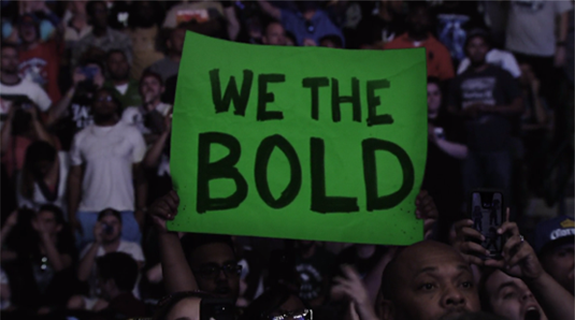A name like USA Network is not taken lightly.
“Our name is our greatest asset,” said Alexandra Shapiro, USA executive vice president of marketing and digital. “It’s our job to reflect the character and spirit of America.”
So when that spirit shifts, USA must shift with it.
While the tagline of “Characters Welcome” has been a successful rallying cry for the number-one network for more than a decade, “there is a time when the world demands a change,” Shapiro said.
“We the Bold” establishes that time is now.
RELATED: USA Network Revamps Brand with ‘We the Bold’ Tagline
USA debuted the new tagline in April as part of a rebranding campaign designed to capture millennial values such as courage, resiliency, risk taking and authenticity as Gen Xers age out of the network’s 18-49-year-old target demographic.
At the same time, the economic crisis of 2008 heralded a darker, grittier national mood that stands in stark contrast to the unflappable optimism in the years immediately following 9/11. Technology—such as social media, VOD and streaming services—also have altered dramatically the way consumers surf channels, moving from live TV to multimedia platforms.
“Everything in combination really changed the zeitgeist as we know it,” Shapiro said. “‘We the Bold’ is about where we’re going and not where we’ve been. Everything we do now, we will use this as a filter.”
USA began extensive market research around the end of 2014, and worked with creative agency BBH Global, which landed the “We the Bold” line.
“This is the one we felt had stopping power,” Shapiro said.
Rife with anti-heroes and themes of challenging authority and government mistrust, hacker drama Mr. Robot and futuristic dystopian thriller Colony are leading USA’s shift, and provide the programming to back its new direction.
USA introduced the campaign through content pieces told from the point of view of characters from each show, along with one featuring WWE superstar Roman Reigns.
What do Elliot Alderson of Mr. Robot, Katie Bowman of Colony and Roman Reigns all have in common?
“They’re risk takers,” said brand strategist Lee Hunt of Lee Hunt LLC.
Hunt worked alongside Shapiro in 2005 to come up with “Characters Welcome,” which at the time differentiated the network by using characters more so than storylines to promote its series. As the company sought to reposition its programming to go beyond linear viewing, Hunt encouraged USA not to abandon that longstanding train of thought, and suggested the network connect its character-focused message to the type of content it plans to pursue.
“We the Bold” does just that. It builds on stories about people and characters, while emphasizing a particular archetype.
“It’s a more narrow focus,” Hunt said. “You know what you’re going to get out of it.”
In each spot, “We the Bold” appears organically within the context of each franchisee’s world, woven into the narrative in a way that’s relevant to each of those characters and their conflicts. In Mr. Robot, each word is shown individually in different styles of propaganda. In Colony, it’s scrawled graffiti-style in red paint, or blood, across a wall, and in the WWE spot a fan in the audience holds a “We the Bold” sign.
If you weren’t aware of the new tagline it would be easy to dismiss, and that’s the point.
“It’s not USA saying ‘We the Bold,’” Hunt said. “It’s the characters saying it. Stuck on like an exclamation point at the end of a promo, it wouldn’t mean the same thing.”
With a multi-platform approach in mind, USA developed socially-focused GIFS for the shows Chrisley Knows Best, Queen of the South and WWE that are punctuated by the tagline in a way that still flows as part of the content pieces.
“Sometimes subtlety speaks louder than shouting something out,” said Hunt.
Indeed, “We the Bold” is never even spoken, at least not yet.
“We’re developing the rules and guidelines in real time,” Shapiro said. “This will be a highly flexible design system.”
So far it appears only as text as USA builds the story around its new tagline one layer at a time. That’s a benefit of being such a large brand.
“You’ve got lots of loyal viewers,” Hunt said. “So there’s the opportunity to message them in a way smaller networks can’t.”
As USA continues to define its programming shift in an on-demand world, Shapiro also points out that the brazen new direction is not just dark for the sake of being dark. The content is still riddled with positive attributes such as bravery and perseverance.
“It’s no longer blue skies, but worlds and characters with glimmers of hope,” she said.
USA will continue to fine-tune the design system around “We the Bold,” coming up with new ways to organically incorporate it into the brand until it becomes ingrained in the fabric of the network’s multiple platforms.
USA has no immediate plans for a larger rebrand down the line, but hopes “We the Bold” will have the same staying power as “Characters Welcome.”
“You never know how something is going to play out with your audience until you get it out there,” Hunt said. “But I think their positioning is rock solid.”
Tags:













































__twocolumncontent.jpg)











